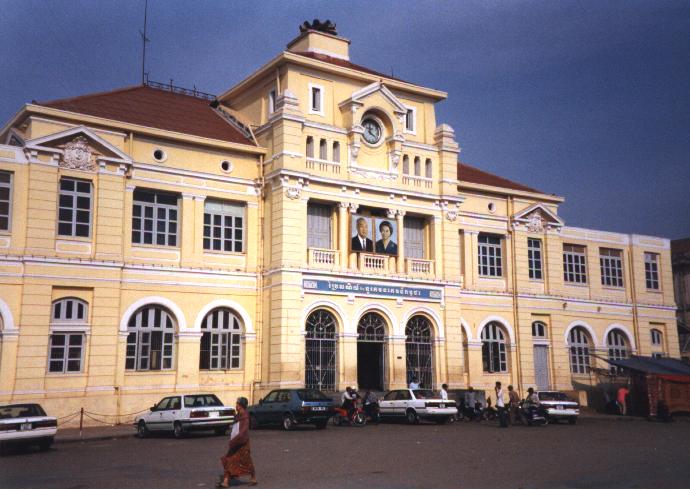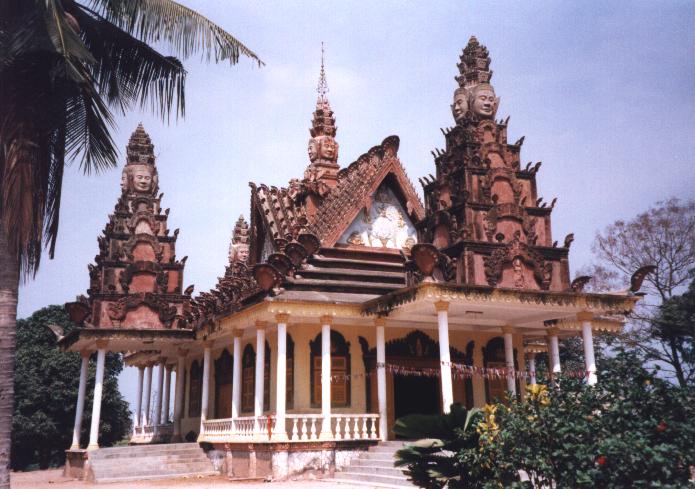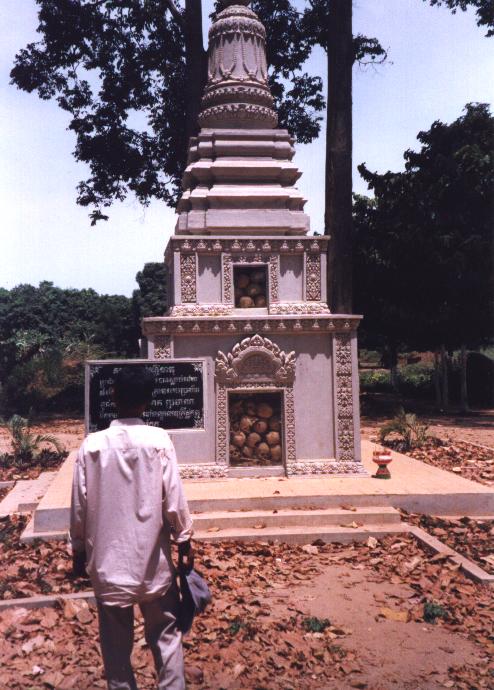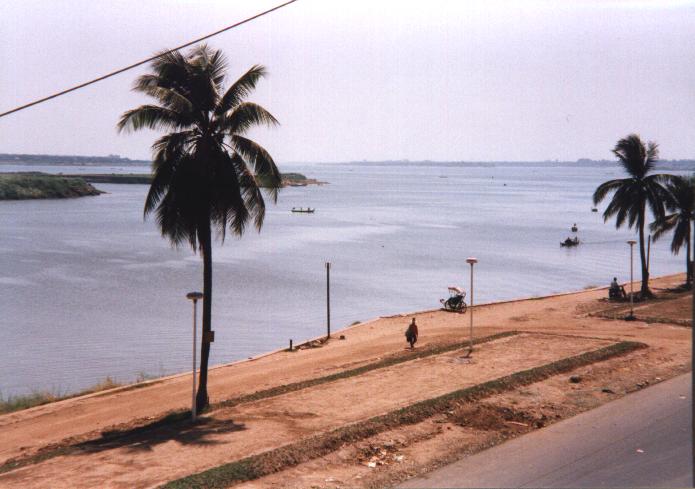ANDYBROUWER.CO.UK
CAMBODIA
TALES 1998
Kien
Svay Away Day
It was my last full day before my
return to England. A week apiece in Siem Reap and Phnom Penh had
only served to highten my passion for Cambodia and its people,
but the burning question remained - "what should I do with
my penultimate day?" A creature of habit, I was up at 6am to
enjoy the sunrise over the meeting place of the Mekong and Tonle
Sap rivers before strolling along the near deserted riverfront to
the FCC for an egg, bacon and coffee breakfast. Returning to my
hotel across the lawns directly in front of the Royal Palace, my
loyal motodub, Onphum, was waiting patiently at the gates. I
explained my dilemma and we agreed on a whistle-stop tour of some
of the city's most prominent features for starters.
 Along the Sisowath Quay waterfront, we
stopped at the main Post Office, resplendent after a recent coat
of yellow paint (left). In stark contrast, the flaking and
run-down buildings surrounding it are home to large numbers of
squatter families, a common enough sight in the capital. Carrying
on up to the Japanese Friendship Bridge, we pulled in briefly at
the dilapidated old Sports Stadium before doubling back to Le
Bibliotheque (the National Library), which had been spruced up -
a shame that the Khmer Rouge had destroyed almost all of the
books it once held - and Hotel Le Royal - once the haunt and
playground of the foreign press corps - and now part of the
Raffles hotel chain, with rooms costing up to $2,000 per night.
Along the Sisowath Quay waterfront, we
stopped at the main Post Office, resplendent after a recent coat
of yellow paint (left). In stark contrast, the flaking and
run-down buildings surrounding it are home to large numbers of
squatter families, a common enough sight in the capital. Carrying
on up to the Japanese Friendship Bridge, we pulled in briefly at
the dilapidated old Sports Stadium before doubling back to Le
Bibliotheque (the National Library), which had been spruced up -
a shame that the Khmer Rouge had destroyed almost all of the
books it once held - and Hotel Le Royal - once the haunt and
playground of the foreign press corps - and now part of the
Raffles hotel chain, with rooms costing up to $2,000 per night.
The Railway Station was deserted -
when the trains to Battambang or Kompong Som are running, they
leave at 6am and foreigners aren't usually allowed to travel -
and the Stupa out front, believed to contain a bone of Buddha,
had recently been painted an egg-shell blue. Someone, somewhere
is making a tidy profit out of all this paint production. It was
the same at Wat Phnom, the small hillock and temple at the top of
Norodom Boulevard, that lends its name to the capital. The area
was swarming with workmen laying concrete and adding the
finishing touches to a refurbishment of the park that had coated
the pagoda in garish red and yellow colours. To help cover the
costs, a $1 entrance fee has been introduced for all visitors.
Next stop was Wat Koh, located
just off the city's main artery, Monivong Boulevard. An oasis of
calm amidst the frenzied early morning traffic, there's a
thriving English language school in the temple grounds with lots
of children keen to practice their few words of English on a
wandering traveller. Onto Wat Sampeou Meas near the Olympic
Stadium, we passed under the main gate with its Bayon-like faces
and the headquarters for Maha Ghosananda and his Dhammayietra
Centre for Peace but found the main vihara closed. The temple at
Wat Tuol Tom Pong was open with its life of Buddha murals
decorating the walls, and like most pagodas, it was surrounded by
a proliferation of classrooms and hordes of boisterous
schoolchildren. On the stroke of 9am, the kids formed orderly
lines and filed into class, leaving Onphum and myself scratching
our heads as to our next destination. He suggested taking a
leisurely ride out to Kien Svay, about fifteen kilometres out
along Route 1 towards Vietnam, where I recalled the presence of a
striking killing fields memorial gleaned from my visit to the
DC-CAM offices a few days earlier, and agreed that would be our
goal.
 Out over
Monivong Bridge and past the Chbam Pao market, the flow of
trucks, cars, buses and motos immediately became heavier as we
headed out along the road that's the major supply route to and
from Vietnam. En route to Kien Svay, we stopped at a number of
peaceful wats, one of which housed a gigantic seated Buddha,
shrouded in construction poles and tarpaulins, just yards from
the main highway. At the other wats, (where I failed to keep a
note of their names but believe they included Wat Angkor Chey,
Knong and Nimoul amongst others), more paint had been liberally
applied to most surfaces and each temple had its own interesting
collection of statues and fantasy creatures, either on horseback
or in some other pose, which Onphum explained as having important
religious or historical significance. We passed by a couple of
well-known restaurants, River View and L'Imprevu as well as the
local Cambodia Trust clinic at Kien Svay before leaving the main
highway in search of our intended destination, Wat Champuk Kaek.
The picture I'd seen at the DC-CAM office showed a large wooden
memorial with row upon row of human skulls, victims of the Khmer
Rouge genocide, in the grounds of the temple. Stopping to ask for
directions, we were directed to a pagoda a couple of kilometres
off Route 1, down a sandy track with rice fields on either side,
the occasional homestead and a surprised look on the faces of the
locals that a mad foreigner was in their neighbourhood. Before we
reached the temple, Onphum's moto slid from beneath us on the
sandy path and we both pitched forward to land in a heap with a
few minor cuts and bruises. Apart from buckled handlebars,
smashed indicator lights and a broken foot pedal, the moto,
Onphum and myself were okay to carry on to the wat which, as it
turned out, wasn't the one we were looking for. However, it was
an unusual temple - one of nearly 3,700 active wats in Cambodia
with at least 50,000 resident monks - with Bayon-style heads atop
each of its buildings (above) and impressive wall paintings
inside the vihara.
Out over
Monivong Bridge and past the Chbam Pao market, the flow of
trucks, cars, buses and motos immediately became heavier as we
headed out along the road that's the major supply route to and
from Vietnam. En route to Kien Svay, we stopped at a number of
peaceful wats, one of which housed a gigantic seated Buddha,
shrouded in construction poles and tarpaulins, just yards from
the main highway. At the other wats, (where I failed to keep a
note of their names but believe they included Wat Angkor Chey,
Knong and Nimoul amongst others), more paint had been liberally
applied to most surfaces and each temple had its own interesting
collection of statues and fantasy creatures, either on horseback
or in some other pose, which Onphum explained as having important
religious or historical significance. We passed by a couple of
well-known restaurants, River View and L'Imprevu as well as the
local Cambodia Trust clinic at Kien Svay before leaving the main
highway in search of our intended destination, Wat Champuk Kaek.
The picture I'd seen at the DC-CAM office showed a large wooden
memorial with row upon row of human skulls, victims of the Khmer
Rouge genocide, in the grounds of the temple. Stopping to ask for
directions, we were directed to a pagoda a couple of kilometres
off Route 1, down a sandy track with rice fields on either side,
the occasional homestead and a surprised look on the faces of the
locals that a mad foreigner was in their neighbourhood. Before we
reached the temple, Onphum's moto slid from beneath us on the
sandy path and we both pitched forward to land in a heap with a
few minor cuts and bruises. Apart from buckled handlebars,
smashed indicator lights and a broken foot pedal, the moto,
Onphum and myself were okay to carry on to the wat which, as it
turned out, wasn't the one we were looking for. However, it was
an unusual temple - one of nearly 3,700 active wats in Cambodia
with at least 50,000 resident monks - with Bayon-style heads atop
each of its buildings (above) and impressive wall paintings
inside the vihara.
 We retreated back to Route 1, a little
worse for wear but determined to continue our search. Revised
directions from a drinks stall owner sent us back amongst the
dusty trails and alleyways before we eventually located Wat
Champuk Kaek a few kilometres from the main highway. We'd almost
given up the search, convinced that we were hopelessly lost when
the archway to the temple entrance came into view. Now accustomed
to temples that had been recently refurbished, Champuk Kaek was
no exception and in addition, the main vihara was much larger
than usual but was unfortunately shut. To one side, there was
some commotion coming from the monks' quarters and as we turned
around, a tall, willowy tree came crashing down to the ground. As
the dust cleared, it revealed that the tree had missed the corner
of the monks' dormitory by the width of a coat of paint! Nearby,
a newly-erected greyish memorial stupa with glass side-panels
held the remains of 1,500 Khmer Rouge victims (left). It had
recently replaced the wooden shed that housed the excavated
skulls, at a site believed to contain 18,000 victims in total. At
that moment, two young boys herded their cattle through the
temple grounds and past the stupa, oblivious to the enormous
suffering that had taken place at that spot twenty years earlier.
We retreated back to Route 1, a little
worse for wear but determined to continue our search. Revised
directions from a drinks stall owner sent us back amongst the
dusty trails and alleyways before we eventually located Wat
Champuk Kaek a few kilometres from the main highway. We'd almost
given up the search, convinced that we were hopelessly lost when
the archway to the temple entrance came into view. Now accustomed
to temples that had been recently refurbished, Champuk Kaek was
no exception and in addition, the main vihara was much larger
than usual but was unfortunately shut. To one side, there was
some commotion coming from the monks' quarters and as we turned
around, a tall, willowy tree came crashing down to the ground. As
the dust cleared, it revealed that the tree had missed the corner
of the monks' dormitory by the width of a coat of paint! Nearby,
a newly-erected greyish memorial stupa with glass side-panels
held the remains of 1,500 Khmer Rouge victims (left). It had
recently replaced the wooden shed that housed the excavated
skulls, at a site believed to contain 18,000 victims in total. At
that moment, two young boys herded their cattle through the
temple grounds and past the stupa, oblivious to the enormous
suffering that had taken place at that spot twenty years earlier.
 Our mission
accomplished, we left the wat and quickly realised we had a
problem - we were lost. However, out of nowhere, a local
ice-cream seller came to our rescue, explained the quickest way
back to Route 1 and in double-quick time Onphum had returned us
to the hustle and bustle of the main highway and back to Phnom
Penh. Hot, sweaty and a little sunburnt, I had a shower back at
the Renakse hotel before a late lunch at the FCC and a few
relaxing drinks on the balcony overlooking the Tonle Sap river
(right). It was my last night in the capital and after a wide
choice of Khmer dishes at the Ponlok restaurant, I gave Onphum
some small gifts as a token of my thanks before he ferried me to
the St Patricks' Day party at the offices of the Irish charity,
Concern. Loud music, Irish jigs and Khmer ramvong dances were the
order of the day, washed down with lots of free drink before
Onphum, who had waited patiently outside, returned me to my hotel
in the early hours. A little more than eight hours later, I
boarded a flight to Bangkok and my latest visit to Cambodia was
complete.
Our mission
accomplished, we left the wat and quickly realised we had a
problem - we were lost. However, out of nowhere, a local
ice-cream seller came to our rescue, explained the quickest way
back to Route 1 and in double-quick time Onphum had returned us
to the hustle and bustle of the main highway and back to Phnom
Penh. Hot, sweaty and a little sunburnt, I had a shower back at
the Renakse hotel before a late lunch at the FCC and a few
relaxing drinks on the balcony overlooking the Tonle Sap river
(right). It was my last night in the capital and after a wide
choice of Khmer dishes at the Ponlok restaurant, I gave Onphum
some small gifts as a token of my thanks before he ferried me to
the St Patricks' Day party at the offices of the Irish charity,
Concern. Loud music, Irish jigs and Khmer ramvong dances were the
order of the day, washed down with lots of free drink before
Onphum, who had waited patiently outside, returned me to my hotel
in the early hours. A little more than eight hours later, I
boarded a flight to Bangkok and my latest visit to Cambodia was
complete.
Cambodia Tales : Messageboard : Steel Pulse : E-mail
The contents of this website cannot be
reproduced or copied without permission of the site author. © Andy Brouwer 2006
 Along the Sisowath Quay waterfront, we
stopped at the main Post Office, resplendent after a recent coat
of yellow paint (left). In stark contrast, the flaking and
run-down buildings surrounding it are home to large numbers of
squatter families, a common enough sight in the capital. Carrying
on up to the Japanese Friendship Bridge, we pulled in briefly at
the dilapidated old Sports Stadium before doubling back to Le
Bibliotheque (the National Library), which had been spruced up -
a shame that the Khmer Rouge had destroyed almost all of the
books it once held - and Hotel Le Royal - once the haunt and
playground of the foreign press corps - and now part of the
Raffles hotel chain, with rooms costing up to $2,000 per night.
Along the Sisowath Quay waterfront, we
stopped at the main Post Office, resplendent after a recent coat
of yellow paint (left). In stark contrast, the flaking and
run-down buildings surrounding it are home to large numbers of
squatter families, a common enough sight in the capital. Carrying
on up to the Japanese Friendship Bridge, we pulled in briefly at
the dilapidated old Sports Stadium before doubling back to Le
Bibliotheque (the National Library), which had been spruced up -
a shame that the Khmer Rouge had destroyed almost all of the
books it once held - and Hotel Le Royal - once the haunt and
playground of the foreign press corps - and now part of the
Raffles hotel chain, with rooms costing up to $2,000 per night.

